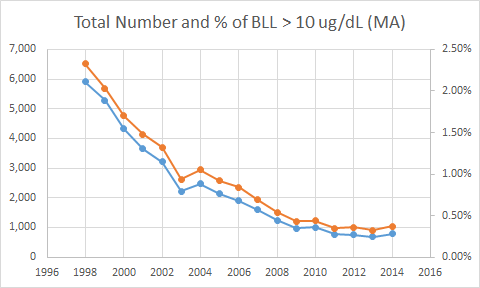Meris Bergquist, Mass Fair Housing Center Sue DPH over Lead Paint Discrimination
| . Posted in News - 3 Comments
Meris Bergquist, Executive Director of the Mass Fair Housing Center (Housing Discrimination Project, Inc.) has directed her organization to sue the Massachusetts Department of Public Health (DPH) over the Massachusetts lead paint law, which they allege to be discriminatory against children “on its face,” meaning obviously and on purpose. They are asking a federal court to declare the law in violation of the Fair Housing Act. They have asked that all landlords be required to delead everything. We obtained and read the full text of their first amended complaint for declaratory and injunctive relief. We disagree with all claims.

Meris Bergquist’s Stated Motivations for the Lawsuit
The Mass Fair Housing Center is a legitimate organization with a legitimate purpose: to end “systemic housing discrimination through education, outreach, advocacy, housing counseling, and enforcement.” Bergquist and MFHC allege that Massachusetts deleading law is discriminatory against children unless it is applied to all rental units, regardless of whether a child occupies them. They want there to be no disincentive to rent to children.
The plaintiffs are two renters who currently have rental housing. They are worried that in the future they might not find housing because of their family status.
As reported by MassLive, Bergquist finds it “shocking that today in Massachusetts qualified applicants for rental housing cannot find it simply and solely because they have a child under the age of six.”
The complaint relies principally on anecdotal evidence of unprepared landlords who make discriminatory statements against applicants with children. A commission report from 1986 (with its 34-year-old data and findings) also features prominently.
A Brief History of Lead Law in Massachusetts
In the early 1970’s, the US Centers for Disease Control started to become officially concerned that elevated blood lead levels are hazardous to children, particularly under the age of six. At the time, they were worried about levels above 80 micrograms per deciliter.
No official actions were taken before Massachusetts blazed the trail. In 1971 we passed sweeping lead legislation, a first in the nation. We banned lead paint in housing and established blood tests by which children would be monitored and treated for poisoning. We set our level at 25 micrograms per deciliter. (The federal government followed suit more slowly, banning lead paint in housing in 1978.)
We also created deleading credits that would fund the removal of lead hazards. So-called “Schedule LP” reimburses owners who delead up to $1,500 per unit.
Objection to Bergquist 1: The Lead Law Is a Role Model of Efficacy
Bergquist and the Mass Fair Housing Center write, “With over 1.8 million housing units in Massachusetts built before 1978 still not considered lead safe, children will likely continue to be exposed to high levels of lead in their homes. As a result, lead exposure continues to pose a significant health risk for children residing in Massachusetts.”
It’s true that the lead paint law has not eliminated lead poisoning, and that we must not stop until every child grows up healthy enough to reach their full potential. But Bergquist and the Mass Fair Housing Center largely ignore any discussion of poisoning. In the 30-page complaint, they only once mention blood lead levels, and then only in the context of an out-of-state study that shows New York has in one county reduced blood lead levels by 85%. What of Massachusetts?
If the law here were ineffective, failing to meet its public policy objectives, then one would expect to see families with children being forced to live in lead-dangerous apartments, and a continued high incidence of lead poisoning among renters. This is not what we see.
Since we passed our lead paint law in 1971, with its revisions over the decades, the number of children with blood lead levels considered to be poisoned has plummeted dramatically across all ages and among all blood lead levels. Even as we have lowered the level that constitutes poisoning, the number of poisoned children has fallen to fractions of what it was.
A graph of CDC data, for instance, shows that the cohort of children under age two with blood lead levels above 10 micrograms has decreased by 80% since 1998, the earliest year for which CDC data was visible online.
In 1971, when the Massachusetts lead law was passed, the United States surgeon general was only concerned with levels above 80 micrograms per deciliter. We have achieved so much that now we are focused on levels above only 10 micrograms per deciliter. We have made remarkable and important progress in eliminating lead at all levels, starting with the most serious cases. Bergquist and the Mass Fair Housing Center do not acknowledge this in the slightest, or consider that possibly the reason the law has been effective is because it has been targeted.

The imposing, tax-payer funded headquarters of Meris Bergquist’s Mass Fair Housing Center, which is suing the taxpayer funded Department of Public Health.
Objection to Bergquist 2: The Lead Law is a Role Model of Targeting
Bergquist and the Mass Fair Housing Center say only 10% of pre-1978 housing stock has been inspected. They write, “There are only two plausible explanations for this trivial rate of preventive deleading: landlords are engaged in rampant housing discrimination against families with children to avoid the costs of lead abatement, or landlords are otherwise violating the Lead Law by refusing to abate lead hazards when renting to these families. In either event, families with children under age six are harmed.”
This low percentage is neither an absurdity nor a crime, as simple demographic calculations will show.
In Massachusetts, only 5.2% of the population are under age 5. (Demographic statistics are only available at the age 5 cutoff, so we should in our heads add some additional percentage to include children between the ages of five and six.) To safely house every child who needs lead-free housing, roughly 5% of our housing stock would have to be deleading compliant. We have twice what is needed!
Since children do not rent apartments on their own, indeed often have siblings at an average rate of over one child per household, the needed number of units per capita would actually be less than this 5%.
Furthermore, since children with elevated blood lead levels are discovered through yearly monitoring, and this triggers an inspection, we can be confident we have already inspected and remediated the most dangerous units. Or if any child is disastrously poisoned today and yet undiscovered, they will be identified and treated within a year. Their apartment will be deleaded immediately as a result. Lead safety is a question of allocation, but not of total housing supply.
Objection to Bergquist 3: The Courts Cannot Compel Spending
The lifetime costs of a single lead poisoning are in the range of $100,000. Compare this to the cost of deleading. Prior to the 2017 revisions, the average cost was $10,000 per unit. Since 2017, the cost has fallen to $6,000 per unit. There are obvious and tremendous advantages to be gained by society’s funding the removal of all lead hazards permanently and forever.
If we had written the 1971 lead law to cover 100% of rental housing, without regard to whether children lived there, we would have needed to spend roughly $10 billion more than we have already spent. From where would this funding have come? The legislature has shown no willingness to allocate additional funds, not even in the form of an inflation adjustment for the deleading credit (which in adjusted terms should now be $5,000 instead of $1,500). “Get The Lead Out” grants and other funding sources are widely underutilized, under-scoped, and in any event inadequately funded. Businesses do not absorb costs, we pass them through to our customers in the form of prices. We ought not have charged $10 billion more in rent these last decades.
Consider the unintended consequences of an unfunded requirement to delead all units:
First, such a policy would greatly increase the pressure to cut corners. If a landlord is truly discriminatory, with no intent to rent to children, it seems unlikely they would feel any moral compunction over a fraudulent deleading. Any corrupt inspector will do, since who’s going to know anyway? No one in the unit will either be sickened or tested. Such a policy would exacerbate the moral hazard to falsify documents, while doing nothing to address a discriminatory root cause.
Second, such a policy would increase the pressure to leave units vacant. Many owners are already inadequately capitalized for their job. So they let their units slide vacantly toward condemnation. Adding more capital requirements just further constrains housing supply for all.
Focusing on child-occupied housing has made sense, and will continue to make sense given a world of finite resources. Our political system has not to date prioritized deleading funding, perhaps because most voters are not aware of the seriousness of lead hazards.
Objection to Bergquist 4: The Lead Law Actually is Flawed, for Single Families not Rentals
Bergquist and the Mass Fair Housing Center are particularly concerned with landlords, “a discriminatory rental housing market for families with children under age six.” In focusing on the minority of evil landlords, the lawsuit misses the lead paint law’s real flaw: the Massachusetts lead law basically does not apply to the majority of owner-occupied housing.
The lead law might be intended to apply to all dwelling units, but the penalties for non-compliance are damages owed to the child. What does it mean for a parent to owe their minor child money? Who has standing on behalf of the child to sue the parent for this judgment? This penalty makes sense only in the context of a third-party owner, where the parents are suing the landlord. The lead paint law was always intended to apply to rental housing.
Note that home sellers (exchanging title) need not delead prior to selling to a family with minor children. Note also the harmful urban legend, that owner-occupied dwellings are somehow cleaner or better cared for by their occupants than rentals. Lead poisoning can happen anywhere. Checking the box at sale, “No knowledge of lead,” is a likewise harmful and rampant evasion.
If we are serious about public health, then we need to find a way to enforce deleading compliance on everyone who houses a child, including parent-owners. By ignoring single family owner-occupied premises, which in Massachusetts represent the lion’s share of all housing, the lawsuit ignores what is actually a legitimate deficiency. Instead of asking the federal courts to protect the minors whose parents are totally unaware of lead hazards, Bergquist and the Mass Fair Housing Center are asking the courts to bring greater enforcement on landlords who are already complying. Except for those of us who need training.
Lawsuit Objection 5: Landlords need Training, this Lawsuit Doesn’t Accomplish That
There are probably some landlords who are lost causes, who laugh at the thought of telling a family with children, “Get out! I shall not rent to anyone who smiles or runs or spills milk on hardwood floors, ha ha ha!” But we have never met such a landlord. The landlords we know who have discriminated (and have been fined for it) were all half-trained. They were aware that lead is dangerous to children. They turned away children in an effort to be protective and helpful. We see it every crash course. We see it every time the Attorney General announces a new lawsuit against a discriminatory landlord.
A fully trained landlord knows that Massachusetts law places us in a Catch-22: we cannot have a child under the age of six living in an apartment with lead hazards, whether known or unknown. But under federal and state law, we cannot turn away families with children, because this would be unlawful discrimination. The law is clear: we must delead. This point is a primary focus of MassLandlords’ training both at our monthly networking and training events and in our crash course. The deleading procedure, the costs, and the manner of obtaining funds are all mysteries to many landlords. We help.
The Mass Fair Housing Center does not fully share our educational mission. According to their website, they litigate 300 cases per year and have obtained hundreds of thousands of dollars in judgments against landlords. One of the plaintiffs in this very litigation has already won a case against their discriminatory landlords. (It’s a wonder the DPH lawsuit hasn’t already been dismissed for lack of standing; they won, but they’re suing again?) The landlords they previously sued are now wiser, at a cost far in excess of our crash course, and possibly driven out of business.
The Mass Fair Housing Center lawsuit provides anecdotal evidence of untrained landlords. They attempt to provide statistics by cherry-picking 27 ads that contain discriminatory phrasing about lead, and then testing those landlords, finding that 93% percent of those landlords were tested and found to be discriminatory. First of all, note that two landlords passed the test. Secondly, note that every day between 7,000 and 20,000 apartments are available for rent. If 27 is the number of discriminatory ads that can be found, then the other 99.6% of ads are compliant as far as lead is concerned.
Any trained landlord knows that the first-time discrimination fine of $10,000 will be more expensive than deleading a unit for $6,000. The Schedule LP deleading credit reduces the cost to $4,500. Optional federal grants and loans can bring the cash outlay down further, possibly to zero, with a string or two attached. And deleading certs have resale value. The Bergquist MFHC lawsuit against DPH will not educate a single owner, except to the extent we at MassLandlords write about it. Such money would make a difference if spent on outreach and full training. But we are wasting money.
Lawsuit Objection 6: The Lawsuit Wastes Public Money
Both the defendant and the plaintiff in this case are taxpayer funded.
The defendant, the Department of Public Health, promulgated the current lead paint regulation. To the extent that the regulations might be flawed beyond their authorizing statute, DPH would be to blame. But DPH is not to blame. Their regulations follow the law. They have not blocked any needed reform. On the contrary, they have reduced deleading costs while simultaneously tightening the standards by which children are protected. We should all be proud of DPH and the work they are doing with our taxes.
The plaintiff, the Massachusetts Fair Housing Center, had a 2018 operating budget of $408,063 per year, of which $308,461 was government grants. Bergquist and the Mass Fair Housing Center are asking the court to add to this operating budget, to make “An award of litigation expenses, attorneys’ fees, and costs.” It’s an exercise in nonprofit empire building.
The law being challenged was written by We the People of Massachusetts, who have the ability to change any law we please in consultation with our representatives in the legislature. Meris Bergquist admits that she did not once talk to her Representative or Senator about reforming the law. And she knows that this is the correct process. In her lawsuit, she asks the court to compel DPH “to work with and advocate for the Massachusetts Legislature to enact a less discriminatory provision of the Lead Law.” Well, amen! She could do that herself, or she could enlist help from us, no need for a lawsuit!
Instead, Bergquist and the Mass Fair Housing Center have decided to direct her taxpayer funded organization to sue DPH and by proxy all taxpayers. If the Mass Fair Housing Center works a year on this case, we might as well have enacted a law to put $308,461 cash into an empty paint can and set it on fire. It’s a patent absurdity. The best possible outcome of this lawsuit will be the legislative reform we ought to have started with for free.
Bergquist Mass Fair Housing Center Lead Lawsuit Conclusion
It is unlikely the federal court hearing the case will request amicus briefs, but if they did, we should surely write one against Bergquist and MFHC. This lawsuit has not been surveyed among our members, but we do know from a related policy priorities survey that at least two-thirds of the membership are in favor of increased deleading credits. Our members would likely be strongly opposed to wrecking an effective and targeted law. We know, especially in a housing crisis, how precious is funding for lead abatement and housing in general.
Bergquist and the Mass Fair Housing Center are assuming malice where incompetence will suffice. Landlords who discriminate against children do so unaware of the policy framework that makes deleading both a required and a more remunerative option. We must not waste taxpayer funds suing ourselves when free legislative remedies exist or where basic training is a likelier solution.
The Governor has appointed a Lead Poisoning Advisory Committee under Chapter 111, Section 190. If ever it was needed, now is the time. The Committee ought to convene and issue a public statement against the use of public funds in this case. To the extent the lead law is the most pressing reform needed today, a consensus reform ought to be drafted and put to the legislature with DPH at our side as ally and faithful public servant instead of as defendant.
Epilogue 1: State Funding
Apparently unaware of this lawsuit, on June 24, 2020 the house voted the Mass Fair Housing Center an additional $150,000 in state funding to continue litigation. The senate version that replaced the house version removed this funding on June 29.




